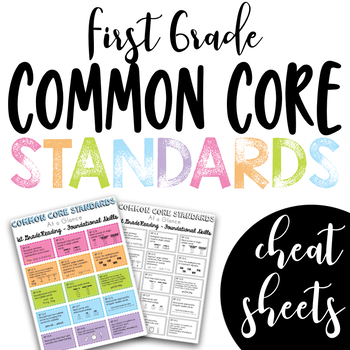First Grade Common Core Standards Cheat Sheets
Happy Little Hearts
6.8k Followers
Grade Levels
1st
Subjects
Resource Type
Standards
CCSS1.MD.A.1
CCSS1.NBT.A.1
CCSS1.OA.A.1
CCSS1.G.A.1
CCSS1.G.A.2
Formats Included
- Zip
Pages
n/a
Happy Little Hearts
6.8k Followers
What educators are saying
A great resource for knowing the standards for each grade level. Super helpful when writing IEP goals. Thank you! :)
This has been SO helpful with trying to make sure I am explicitly teaching each standard. I love that it is easy to read and not super overwhelming either!
Description
These Common Core Standards cheat sheets are a MUST HAVE for first grade teachers! They are set up in an organized, visually pleasing way, with visuals/examples for each standard to help you locate and understand the standards quickly.
Both color and black and white versions are included!
All CCSS standards are included in this product - Math, Reading, Writing, Listening and Speaking, and Language.
PLEASE NOTE: Common Core does not have science and social studies standards, those are chosen at the state level and are different from state to state, thus this resource does not include science and social studies.
I hope these standards cheat sheets are a helpful tool for your planning and instruction!
Total Pages
n/a
Answer Key
N/A
Teaching Duration
N/A
Report this resource to TPT
Reported resources will be reviewed by our team. Report this resource to let us know if this resource violates TPT’s content guidelines.
Standards
to see state-specific standards (only available in the US).
CCSS1.MD.A.1
Order three objects by length; compare the lengths of two objects indirectly by using a third object.
CCSS1.NBT.A.1
Count to 120, starting at any number less than 120. In this range, read and write numerals and represent a number of objects with a written numeral.
CCSS1.OA.A.1
Use addition and subtraction within 20 to solve word problems involving situations of adding to, taking from, putting together, taking apart, and comparing, with unknowns in all positions, e.g., by using objects, drawings, and equations with a symbol for the unknown number to represent the problem.
CCSS1.G.A.1
Distinguish between defining attributes (e.g., triangles are closed and three-sided) versus non-defining attributes (e.g., color, orientation, overall size); build and draw shapes to possess defining attributes.
CCSS1.G.A.2
Compose two-dimensional shapes (rectangles, squares, trapezoids, triangles, half-circles, and quarter-circles) or three-dimensional shapes (cubes, right rectangular prisms, right circular cones, and right circular cylinders) to create a composite shape, and compose new shapes from the composite shape.





